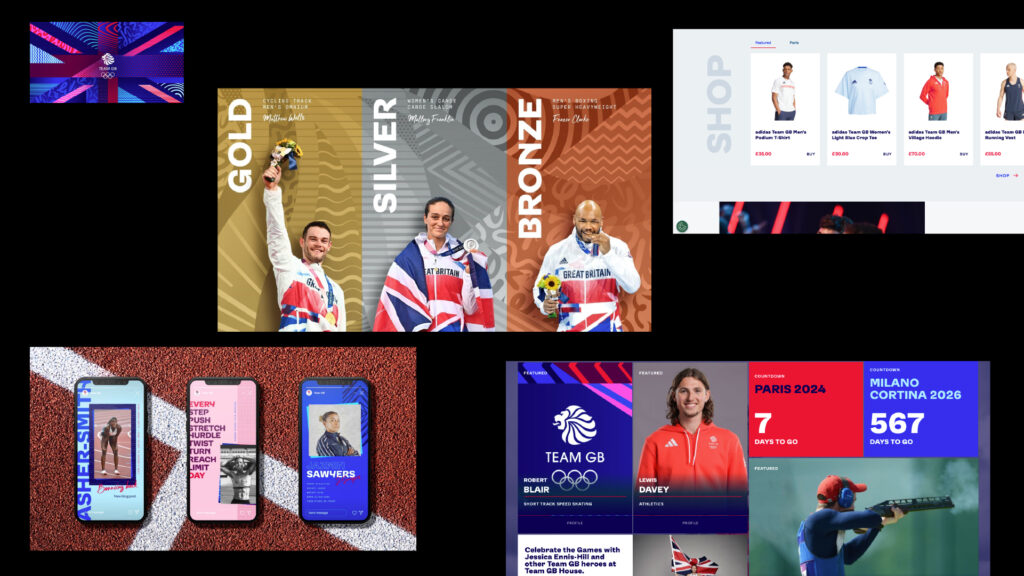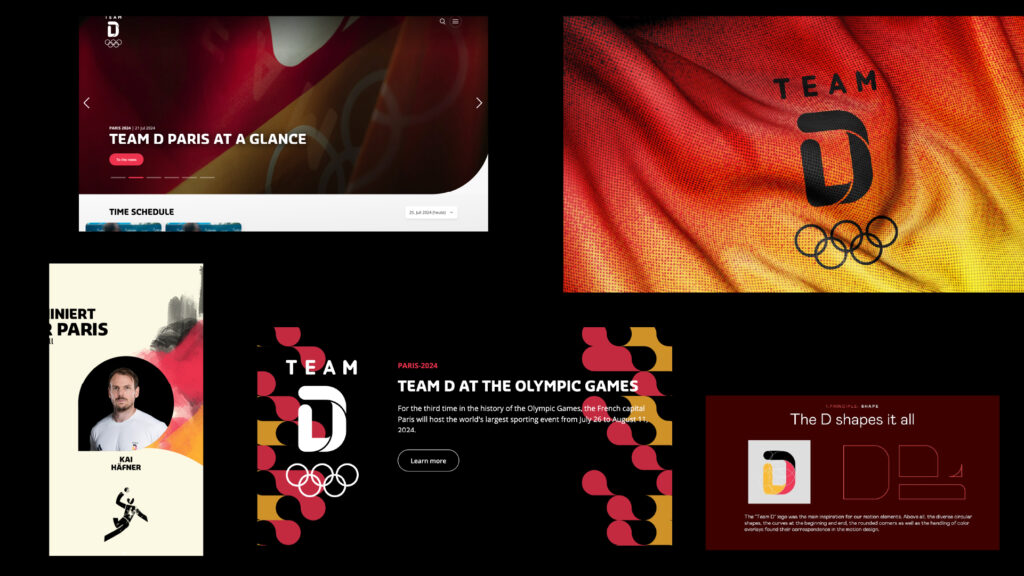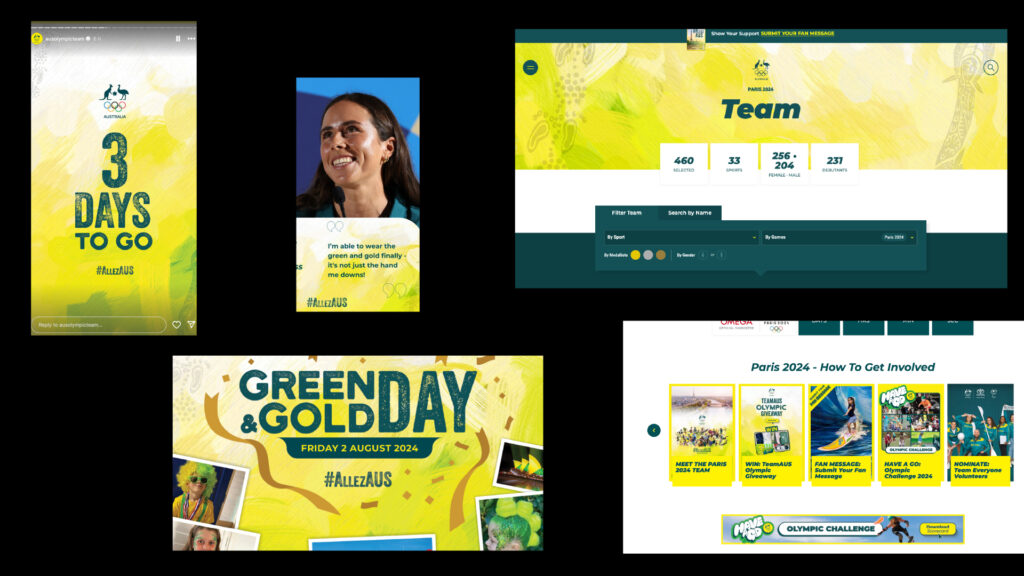A look at how countries have adapted their branding for the 2024 Olympics.
Well, that came around fast…Granted it’s only been three years since the Tokyo Olympics, but with the Paris Olympics kicking off last night we have our eyes on the prize. Who’s winning Gold? Branding gold, that is. With Great Britain completing a full rebrand in the lead up to the 2024 Olympics campaign, Germany adding motion branding to their 'Team D' identity and USA launching a new marketing strategy and brand platform, the competition is heating up - and Australia's been left behind. So let's dive in..
While the world is going minimal, Great Britain embraced maximalism for the rebrand ahead of the 2024 Olympic Games. Studio Thisaway and typographer Lewis McGuffie created a new brand for the team to build interest from a Gen Z audience, establish excitement inbetween the Summer and Winter games and build a digital-first brand. Maintaining the existing logo, Thisaway expanded on the colour palette by adding pinks and purples to the existing red, white and blue, created abstract patterns inspired by athletes but not associated with a particular sport, and created a new typeface built for movement. An insight into the positioning is the change of tagline from ‘Believe in Extraordinary’ to 'Everyday Extraordinary’, emphasising the everyday people involved in the games, from athletes to fans.
“Ahead of Paris 2024 and beyond, the BOA were looking to maintain and grow the brand’s profile amongst fans of all ages and backgrounds, strengthen its relationship with sponsors and commercial partners, and make sure it would be fit for today’s modern, digital-first communication landscape.”

The verdict: An adaptable brand that is clever in its ability to dial up or dial down at different times, with enough flexibility to meet the needs of countless amounts of content and platforms. Extra points for creating a colour palette that deviates from the country colours.
With their Team D brand in hand, introduced at the 2018 Winter Olympics in Pyeongchang, Germany took the opportunity to extend its branding with motion to allow for the diversity of applications required. Audio and Motion Branding Studio Why Do Birds formed a new motion brand for the team based on three core design principles; the form created in the ‘D’ shape of the logo; the colours of the team - always used in the order of the flag; and the tension of anticipation and movement often seen in sport (think the slow pulling back of the bow before the arrow shoots off with speed). The framework is flexible enough to be used across a mix of formats and moods, from serious narrative videos to exciting social media clips, with custom templates created for the rollout across TV, Tiktok and Instagram.

The verdict: A brand made for 2024. In 2018 the German Olympic Sports Confederation (DOSB) chose to create a distinct brand identity for the Olympic team, historically competing under the DOSB brand they embraced a major shift to provide a new symbol of unity, ‘Team D’. Building motion into the 2018 rebrand is a clever and important addition, further cementing the brand in the minds of the audience and ensuring consistency and unity across all content.
As we have come to expect, the United States showcase a larger than life presence and their 2024 Olympic campaign is no different. The U.S. Olympic & Paralympic Committee (USOPC) engaged Weiden + Kennedy New York to form a new strategy that highlights the diversity of their athletes and appeals to a Gen Z audience. The result is a brand platform and ad spots that show diversity as the superpower of the Olympians, and, similarly to GB, humanises the olympians and makes them relatable to their audience. Weiden + Kennedy’s strategy identifies the need for fans to follow the individual people as well as the team, showing personality and relatability rather than a more traditional statuesque Olympian representation. Their social media content focuses on athlete stories including struggles, comebacks and triumphs, providing fans with a deeper connection to the athletes.
Jess Park, the USOPC’s chief of brand and fan engagement, explains that the new strategy and brand platform’s intentions are to “explore the intersection of personality meeting performance — and beyond that, celebrating the communities of people that have surrounded and supported our athletes throughout their journeys.”

The verdict: A brand that’s always at the top. Humanising athletes, allowing for stories to be shared and audiences to connect is key in 2024. Team USA has created the platform and the content for regular, inspiring, branded content that showcase their athletes.
So how does Australia compare?
We all know how much Aussies love sport, from Soccer to Tennis to Swimming, we will get into anything that allows us to come together and cheer on fellow Australians. With some of the greatest sporting moments in history coming from the Olympic Games, think Cathy Freeman winning Gold in the 400m sprint in 2000 or Kieran Perkins’ comeback from lane eight to win the 1500m Gold in Atlanta in 1996, we’re all aboard the Olympic train. Unfortunately the branding has been left behind. With outdated brand material and no attempt to update or add to our existing brand, Team Australia lacks the finesse and contemporary, digital nature of other teams. We’ve seen Australian team branding done well with individual teams, for example, the Matildas most recent 2023 World Cup campaign ‘Til it’s done by Ogilvy, and the excitement and anticipation that comes with it. A lack of brand development is a missed opportunity in the lead up to the Olympics for the Aussies - let’s hope they do better on the field, and track, and in the pool…

The Takeaway
Sporting moments can bring communities together, allowing comradery across generations, sharing the wins, the highs and the lows. The potential for social media is greater than it has ever been and with it comes new opportunities for countries and their athletes to get support and engagement before and during the events. Importantly, a strong brand holds value, not only for the country and the team, but for the individuals competing. Constantly adapting, focusing on engagement and platforming athletes needs to be the focus of every Olympic team.
